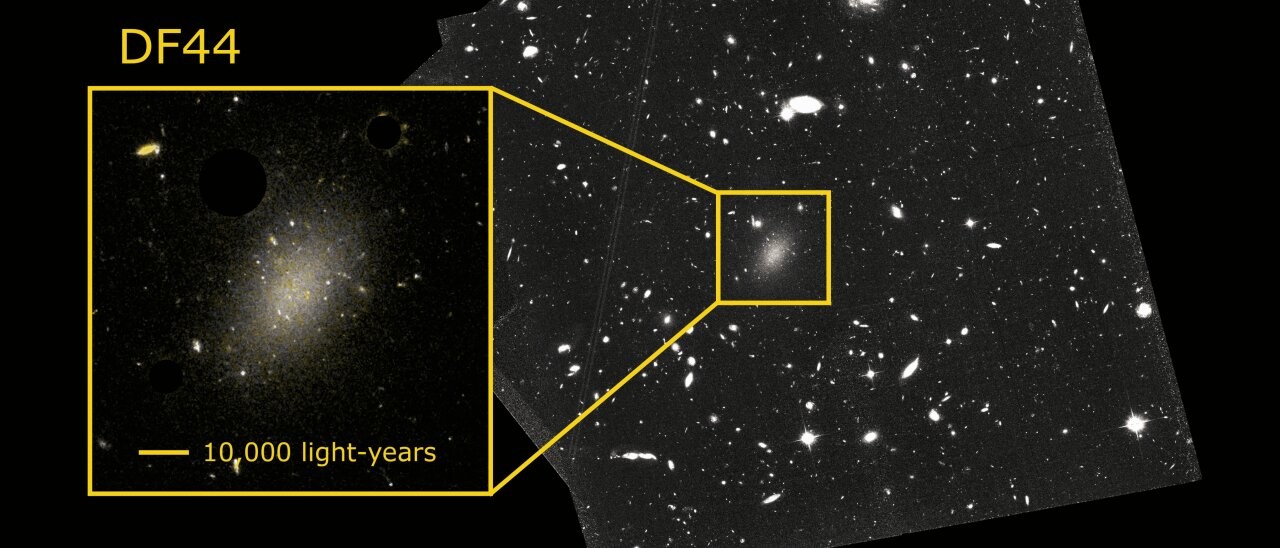A few years ago, astronomers announced the discovery of a galaxy almost entirely made up of dark matter. Many researchers were then surprised, insofar as such an object does not fit our current models of galaxy formation and evolution. A new study finally contradicts these observations.
It was in the 1970s that the idea of dark matter really began to emerge. To summarize, we know that the speed at which a star must move to stay in its orbit depends on the force of gravity which attracts it towards the center of its galaxy, and therefore on the mass of this one. By focusing on the velocities of several stars in the Milky Way, astronomer Vera Rubin realized at the time that the amount of matter needed to keep these stars in their orbits was very insufficient .
In other words, the mere presence of gas and dust, baryonic, or "normal" matter, did not explain stellar motions. We have therefore suggested the presence of another form of matter, invisible, capable of explaining these movements . For information, it is estimated today that this famous "dark matter" makes up about 26.8% of the Universe against only 4.9% for the normal material. The rest is dark energy.
Over the years, astronomers have continued to measure the amount of dark matter present around galaxies and have found that it varies between 10 and 300 times the amount of visible material . However, four years ago, the discovery of a very diffuse object, named Dragonfly 44, changed this view. You will find it in the Coma cluster, a cluster of several thousand galaxies.
From the start, Dragonfly 44 surprised everyone in that it had almost as much dark matter as the Milky Way, the equivalent of a billion solar masses.
However, instead of containing several hundred billion stars, like the Milky Way, Dragonfly 44 only has one hundred million, a thousand times fewer. This means that the amount of dark matter was ten thousand times greater than that of its stars . In other words, there were far, far too many.
Surprised by this discovery, astronomers have multiplied their efforts to try to understand these observations. Were they really real?

In an attempt to find out, researchers from the Kapteyn Institute of the University of Groningen (Netherlands) focused on studying its globular clusters.
The total number of clusters is indeed related to the total mass of a galaxy. Thus, by measuring the number of these clusters, and knowing the number of stars contained in a galaxy, you can determine the amount of dark matter contained inside.
As part of this work, astronomers eventually found that the total number of globular clusters around Dragonfly 44 had been greatly overestimated . They only isolated about twenty, compared to eighty a few years ago. Therefore, the content of dark matter is actually much lower than previous findings had suggested (only 300 times higher than that of luminous matter).
Dragonfly 44 is therefore ultimately not unique. "In fact, with the number of globular clusters we found, the amount of dark matter in Dragonfly 44 is consistent with what is expected for this type of galaxy “, assures Ignacio Trujillo, lead author of the study. "The visible matter to dark matter ratio is no longer 1 in 10,000, but 1 in 300 “.
"Dragonfly 44 has been an anomaly for all these years that could not be explained with existing galaxy formation models" , adds Teymoor Saifollahi, co-author of the article. “We now know that the previous results were wrong and that DF44 is not extraordinary. It's time to move on “.
Details of this work are published in the Monthly Notices of the Royal Astronomical Society (MNRAS).